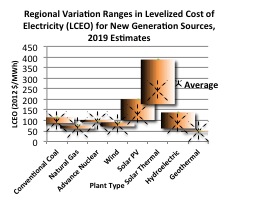Future potential of Photovoltaics domestically is quite significant. With an ever increasing reliance on renewable energy, hypothetical substantial solar future scenarios highlight the ever-present potential of solar PV.
The Sunshot Vision Study (2012) conducted by the U.S. Department of Energy with contributions from the National Renewable Energy Laboratory (NREL) and various other organizations used current trends to project an achievable energy infrastructure where solar PV accounts for 14% to 27% of U.S. electricity demand by 2030 and 2050 respectively. [2]
While this follows the assumption that PV costs will decrease by roughly 75% in all markets, predictions by the EIA suggest that levelized costs of electricity (LCOE) for solar PV is likely to become competitive with other energy sources in the utility market.
LCOE: PV vs. Other Plant Types
Levelized Costs of Electricity (LCOE) can show the general “competitiveness” of different electricity-generating plant types. Expressed in 2012-U.S.$/kwh, LCOE incorporates fuel costs, capitol costs, O&M costs, financing costs, and utilization rates. [1]
Different costs way more heavily depending on plant type. For Example, renewable energy sources require no fuel costs; thus, their regional variations in LCOE is likely a result of varying regional capitol costs.
The following graph shows predicted 2019 regional variations in LCOE for various plant types. This shows that solar PV has the potential to become a regionally competitive energy source in the near future.
Author: Kevin Jackson
Editor: Abby Studen, Hannah Goldstein
Sources:
[1] U.S. Energy Information Administration. (April 2014). Levelized Cost and Levelized Avoided Cost of New Generation Resources in the Annual Energy Outlook 2014
[2] U.S. Department of Energy. (2012). Sunshot Vision Study
